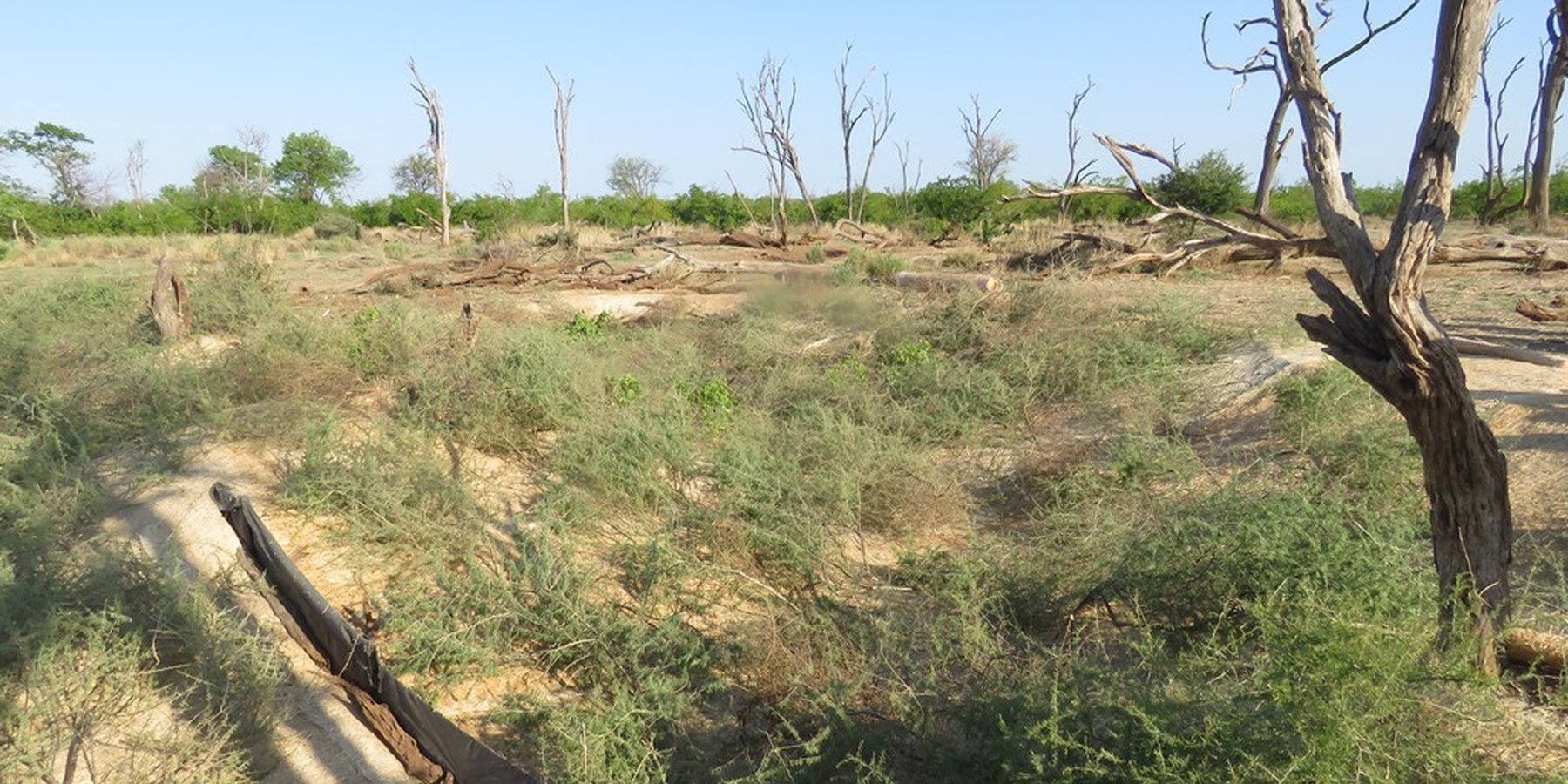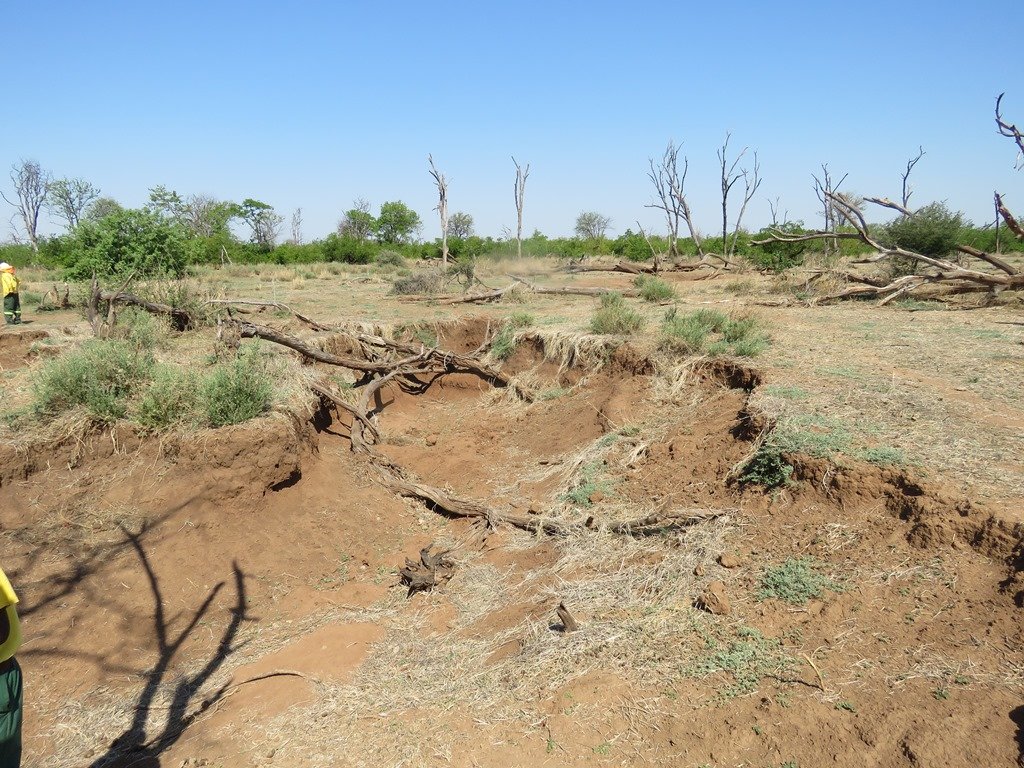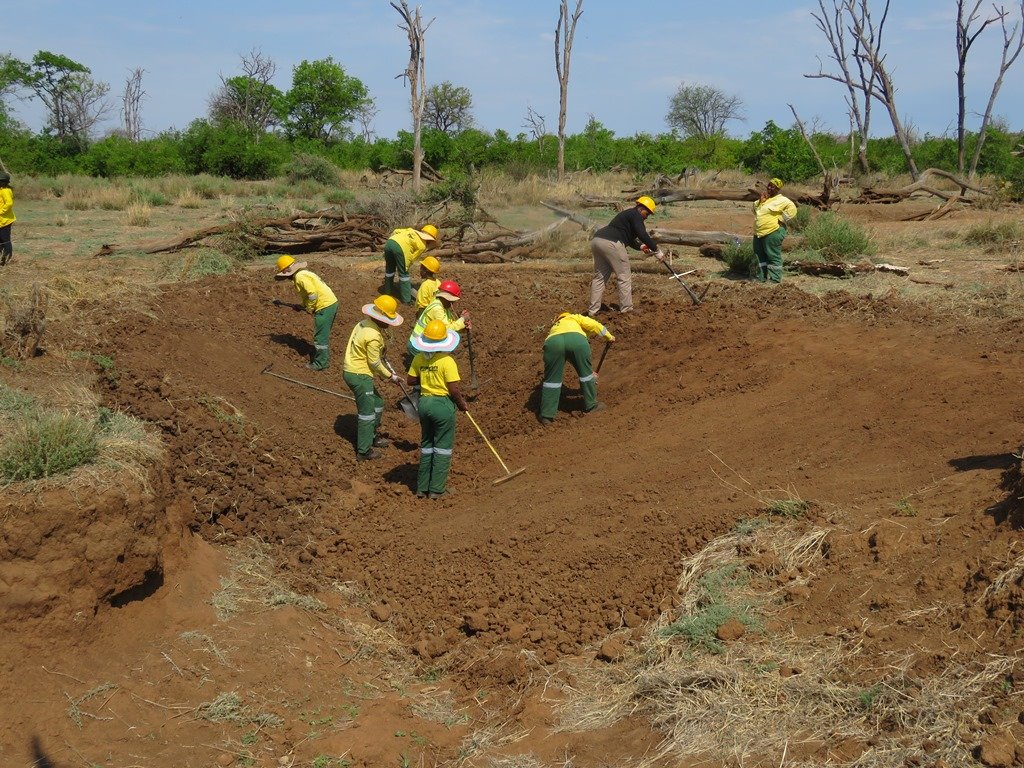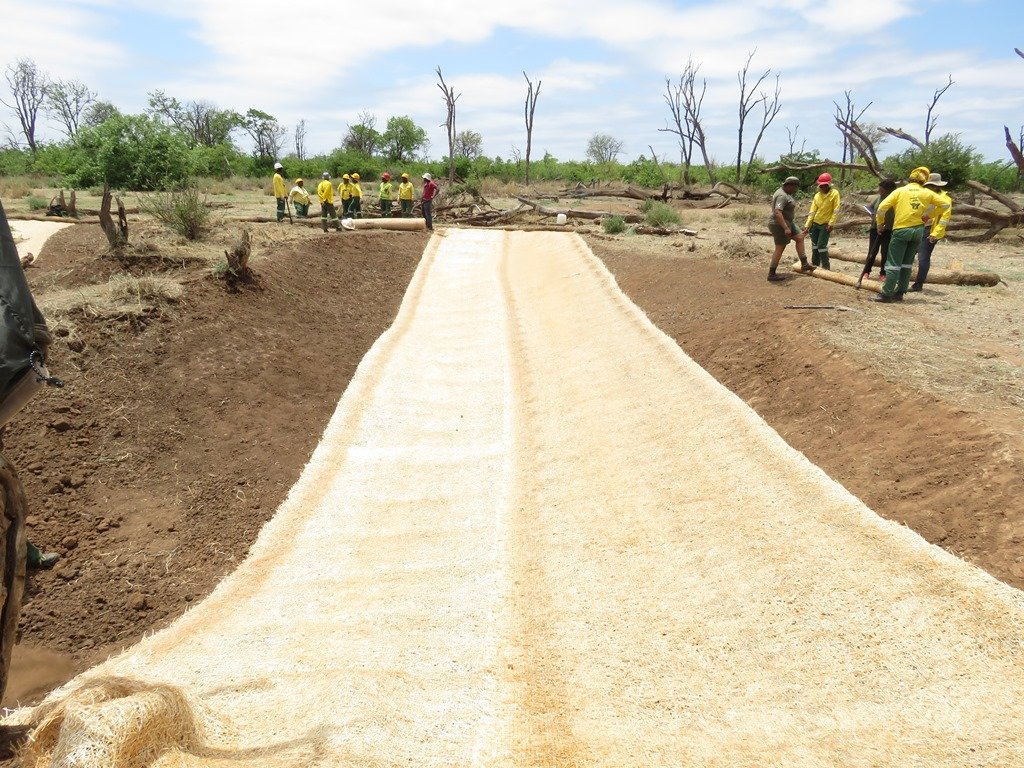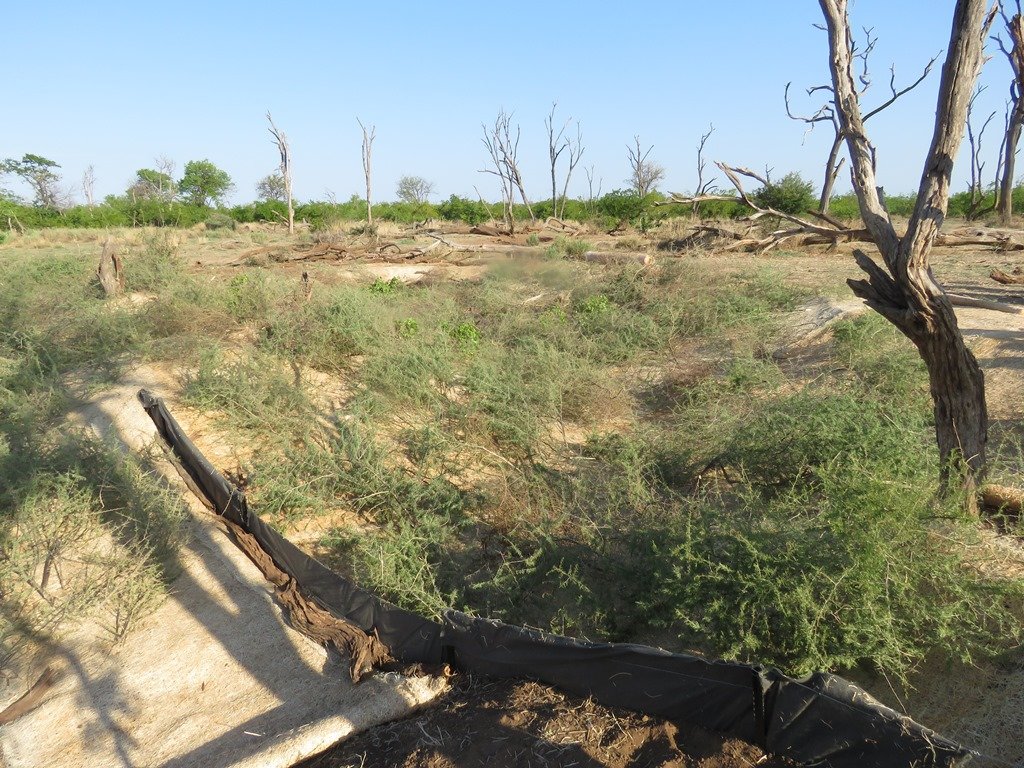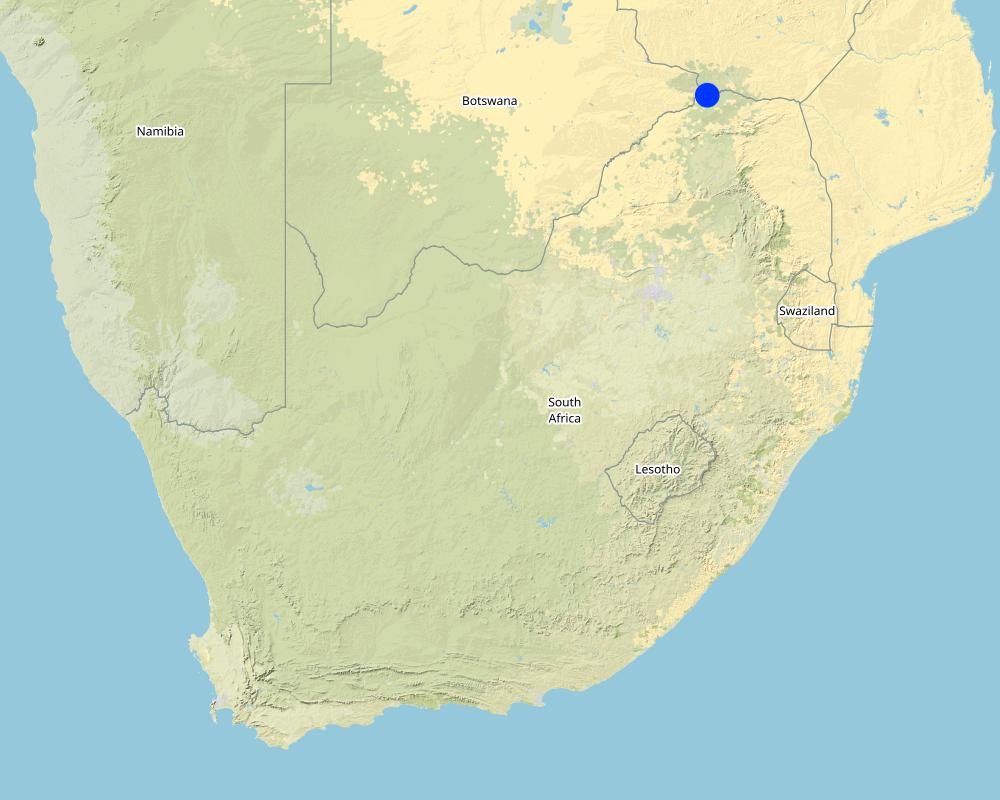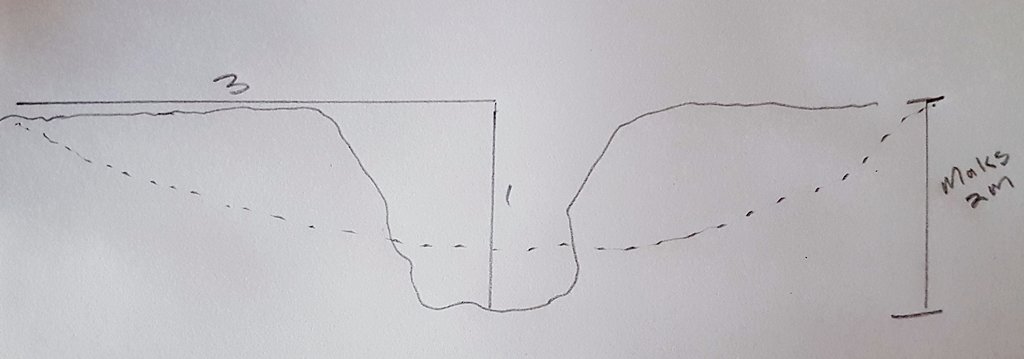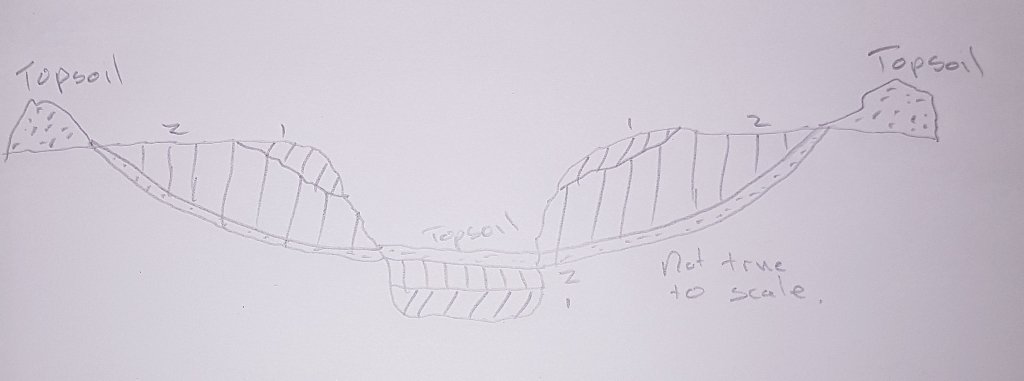Remodelage de ravines par la mise en place de barrières à sédiments, de nattes anti-érosion et d’entassement de broussailles [Afrique du Sud]
- Création :
- Mise à jour :
- Compilateur : Dirk Pretorius
- Rédacteur : –
- Examinateurs : Alexandra Gavilano, Rima Mekdaschi Studer, Brigitte Zimmermann, Donia Mühlematter, Joana Eichenberger
Remodelage des ravines
technologies_3359 - Afrique du Sud
- Résumé complet en PDF
- Résumé complet en PDF pour impression
- Résumé complet dans le navigateur
- Résumé complet (non formaté)
- Remodelage de ravines par la mise en place de barrières à sédiments, de nattes anti-érosion et d’entassement de broussailles: 10 août 2018 (inactive)
- Remodelage de ravines par la mise en place de barrières à sédiments, de nattes anti-érosion et d’entassement de broussailles: 19 février 2019 (inactive)
- Remodelage de ravines par la mise en place de barrières à sédiments, de nattes anti-érosion et d’entassement de broussailles: 2 novembre 2021 (public)
- Reshaping of gully erosion through integration of silt fences, erosion blankets and brush packing: 20 avril 2018 (inactive)
- Reshaping of gully erosion through integration of silt fences, erosion blankets and brush packing: 20 mars 2018 (inactive)
- Reshaping of gully erosion with integration of silt fences, erosion blankets and brush packing: 2 février 2018 (inactive)
Voir les sections
Développer tout Réduire tout1. Informations générales
1.2 Coordonnées des personnes-ressources et des institutions impliquées dans l'évaluation et la documentation de la Technologie
Personne(s)-ressource(s) clé(s)
Spécialiste GDT:
Buckle Jacob
Department of Environmental Affairs - South Africa
Afrique du Sud
Nom du projet qui a facilité la documentation/ l'évaluation de la Technologie (si pertinent)
Working on Ecosystems (Natural Resource Management Programmes – DEA, South Africa)Nom du projet qui a facilité la documentation/ l'évaluation de la Technologie (si pertinent)
Book project: Guidelines to Rangeland Management in Sub-Saharan Africa (Rangeland Management)Nom du ou des institutions qui ont facilité la documentation/ l'évaluation de la Technologie (si pertinent)
SMC Synergy (SMC Synergy) - Afrique du Sud1.3 Conditions relatives à l'utilisation par WOCAT des données documentées
Le compilateur et la(les) personne(s) ressource(s) acceptent les conditions relatives à l'utilisation par WOCAT des données documentées:
Oui
1.4 Déclaration sur la durabilité de la Technologie décrite
Est-ce que la Technologie décrite ici pose problème par rapport à la dégradation des terres, de telle sorte qu'elle ne peut pas être déclarée comme étant une technologie de gestion durable des terres?
Non
1.5 Référence au(x) Questionnaires sur les Approches de GDT (documentées au moyen de WOCAT)
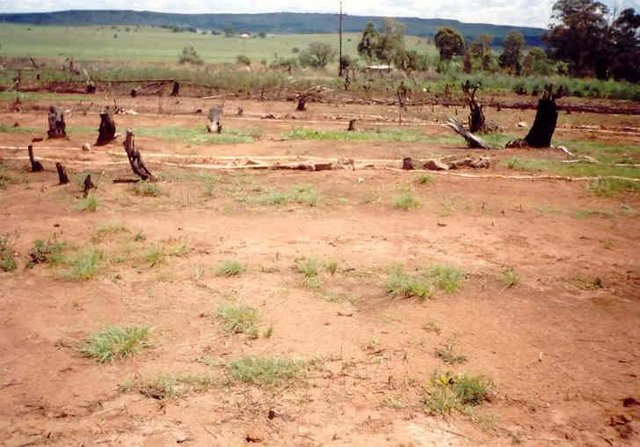
Working for Water [Afrique du Sud]
Government funded restoration/rehabilitation initiative as part of Working for Water project. Aim was to eradicate alien invasive.
- Compilateur : Klaus Kellner
2. Description de la Technologie de GDT
2.1 Courte description de la Technologie
Définition de la Technologie:
La réhabilitation de ravines d’érosion actives par le remodelage des flancs de la ravine afin de gérer l’énergie de l’eau qui entre dans le système. Le sol nu est protégé de l’érosion par une natte anti-érosion, l’entassement de broussailles et la mise en place de barrières à sédiments.
2.2 Description détaillée de la Technologie
Description:
Ce projet de remodelage de ravines a été conduit dans le Parc National de Mapungubwe, dans la province du Limpopo en Afrique du Sud. La zone reçoit des pluies estivales, en moyenne 600-700 mm par an. Les orages sont fréquents. Les têtes de ravines remontent activement vers l’amont à cause du surpâturage sur des sols hautement érodables. Cette technologie de remodelage peut servir pour toute ravine jusqu’à 2 m de profondeur (même sur des sols à duplex – hautement érodables – du gypse devra être ajouté à la terre arable replacée en surface). L’objectif du remodelage est de diminuer le gradient des têtes de ravines et de leurs flancs, réduisant ainsi l’énergie de l’eau d’écoulement. Il permet aussi d’améliorer la couverture végétale et de diminuer le transport des sédiments dans la ravine. Le remodelage des ravines se fait par étapes :
Première étape : retirer toute la végétation viable et utile qui sera affectée par le remodelage, dans et autour du système de ravine active, et la mettre de côté pour la replantation.
Deuxième étape : déplacer la couche arable du sol réutilisable sur les bords de la future ravine remodelée.
Troisième étape : reformer les flancs de la ravine selon une pente de 1:3 (en tenant compte du nouveau plancher de la ravine après remplissage avec la terre des flancs – voir le schéma). Commencer en retirant le haut des flancs en le déposant au fond de la ravine. Faire attention de compacter la terre tout en émiettant les mottes. Continuer à retirer la terre des flancs et la compacter en couches pour former un profil en forme de disque (voir le schéma en coupe).
Quatrième étape : répartir régulièrement la couche arable sur la nouvelle pente créée. Ajouter de la semence de graminées indigènes (si disponibles, sinon graminées exotiques).
Cinquième étape : construire les barrières à sédiments (en tissu filtrant – géotextile) au-dessus des points d’entrée de l’eau et à l’intérieur du profil nouvellement formé (éloignés d’environ 10 m).
Sixième étape : couvrir la zone avec une natte anti-érosion (bio-jute) et/ou du mulch et/ou de la biomasse par entassement de broussailles épineuses locales.
Septième étape : replanter les plantes récupérées – protéger si possible la zone par des clôtures jusqu’à ce que l’herbe se soit installée.
2.3 Photos de la Technologie
2.5 Pays/ région/ lieux où la Technologie a été appliquée et qui sont couverts par cette évaluation
Pays:
Afrique du Sud
Région/ Etat/ Province:
province du Limpopo
Autres spécifications du lieu:
Mapungubwe National Park
Spécifiez la diffusion de la Technologie:
- appliquée en des points spécifiques ou concentrée sur une petite surface
Est-ce que les sites dans lesquels la Technologie est appliquée sont situés dans des zones protégées en permanence?
Oui
Si oui, veuillez préciser:
Parc National
Map
×2.6 Date de mise en œuvre de la Technologie
Indiquez l'année de mise en œuvre:
2017
2.7 Introduction de la Technologie
Spécifiez comment la Technologie a été introduite: :
- par le biais de projets/ d'interventions extérieures
Commentaires (type de projet, etc.) :
Travail sur les services écosystémiques.
3. Classification de la Technologie de GDT
3.1 Principal(aux) objectif(s) de la Technologie
- réduire, prévenir, restaurer les terres dégradées
- préserver l'écosystème
- protéger un bassin versant/ des zones situées en aval - en combinaison avec d'autres technologies
- réduire les risques de catastrophes
- créer un impact social positif
3.2 Type(s) actuel(s) d'utilisation des terres, là où la Technologie est appliquée

Pâturages
Pâturage extensif:
- Ranching
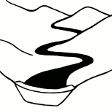
Voies d'eau, plans d'eau, zones humides
- Voies de drainage, voies d'eau
- Marécages, zones humides
Principaux produits/ services:
Piège à sédiments, plaine alluviale inondable.
Commentaires:
Nombre de période de croissance par an: 1
Pluies estivales – octobre à avril
Densité d'élevage/ chargement: Elevée – gibier (diverses espèces)
3.4 Approvisionnement en eau
Approvisionnement en eau des terres sur lesquelles est appliquée la Technologie:
- pluvial
3.5 Groupe de GDT auquel appartient la Technologie
- Amélioration de la couverture végétale/ du sol
- mesures en travers de la pente
- gestion des eaux de surface (sources, rivières, lacs, mers)
3.6 Mesures de GDT constituant la Technologie

structures physiques
- S6: Murs, barrières, palissades, clôtures

modes de gestion
- M3: Disposition/plan en fonction de l'environnement naturel et humain
3.7 Principaux types de dégradation des terres traités par la Technologie

érosion hydrique des sols
- Wg: ravinement/ érosion en ravines
- Wo: effets hors-site de la dégradation

dégradation hydrique
- Hp: baisse de la qualité des eaux de surface
- Hw: réduction de la capacité tampon des zones humides
3.8 Prévention, réduction de la dégradation ou réhabilitation des terres dégradées
Spécifiez l'objectif de la Technologie au regard de la dégradation des terres:
- réduire la dégradation des terres
- restaurer/ réhabiliter des terres sévèrement dégradées
4. Spécifications techniques, activités, intrants et coûts de mise en œuvre
4.1 Dessin technique de la Technologie
Spécifications techniques (associées au dessin technique):
Réhabilitation des ravines érodées – 0,5 m à 2 m de profondeur.
Remodelage les rives de la ravine, de la verticale jusqu’à une pente d’environ 30°.
Des barrières à sédiments sont installées au-dessus de la tête de ravine et à l’intérieur de la ravine remodelée, à environ 10 m l’une de l’autre.
Entassement de broussailles avec de la biomasse d’épineux pour empêcher le pâturage et fournir un microclimat de germination et de croissance aux graines de graminées.
Les barrières à sédiments sont un dispositif temporaire utilisé sur les sites de réhabilitation pour diminuer le mouvement des sédiments vers l’aval. Une barrière consiste en une bande de tissu synthétique filtrant (appelé aussi géotextile) tendu entre une série de piquets en bois ou métalliques selon une courbe de niveau horizontale.
Auteur:
J Buckle
Date:
17/01/2018
4.2 Informations générales sur le calcul des intrants et des coûts
Spécifiez la manière dont les coûts et les intrants ont été calculés:
- par superficie de la Technologie
Indiquez la taille et l'unité de surface:
0.017 ha
Indiquez le taux de change des USD en devise locale, le cas échéant (p.ex. 1 USD = 79.9 réal brésilien): 1 USD = :
12,0
Indiquez le coût salarial moyen de la main d'œuvre par jour:
R140/jour
4.3 Activités de mise en place/ d'établissement
| Activité | Calendrier des activités (saisonnier) | |
|---|---|---|
| 1. | Retirer les plantes | 2 à 3 mois avant les pluies d’été |
| 2. | Retirer la terre arable | 2 à 3 mois avant les pluies d’été |
| 3. | Reformer, compacter en couches | 2 à 3 mois avant les pluies d’été |
| 4. | Réensemencer | 2 à 3 mois avant les pluies d’été |
| 5. | Installation des nattes anti-érosion | 2 à 3 mois avant les pluies d’été |
| 6. | Barrières à sédiments | 2 à 3 mois avant les pluies d’été |
| 7. | Entassement de broussailles | 2 à 3 mois avant les pluies d’été |
4.4 Coûts et intrants nécessaires à la mise en place
| Spécifiez les intrants | Unité | Quantité | Coûts par unité | Coût total par intrant | % du coût supporté par les exploitants des terres | |
|---|---|---|---|---|---|---|
| Main d'œuvre | Main-d’œuvre non qualifiée (y compris le transport) | par jour | 60,0 | 240,0 | 14400,0 | |
| Equipements | Pioches, pelles, compacteur manuel, pinces, trémie, scie à bûches, marteau, brouette (location des outils) | par jour | 35,0 | 20,0 | 700,0 | |
| Matériel végétal | Mélange de semences de graminées | par Kg | 2,0 | 75,0 | 150,0 | |
| Matériaux de construction | Nattes anti-érosion | par mètre carré | 170,0 | 15,0 | 2550,0 | |
| Matériaux de construction | Barrières à sédiments | par mètre | 16,0 | 15,0 | 240,0 | |
| Coût total de mise en place de la Technologie | 18040,0 | |||||
| Coût total de mise en place de la Technologie en dollars américains (USD) | 1503,33 | |||||
Si le coût n'est pas pris en charge à 100% par l'exploitant des terres, indiquez qui a financé le coût restant:
Department of Environmental Affairs - NRM programmes
4.5 Activités d'entretien/ récurrentes
| Activité | Calendrier/ fréquence | |
|---|---|---|
| 1. | Restaurer les sites après les crues (barrières à sédiments et entassement de broussailles) | après les crues |
4.6 Coûts et intrants nécessaires aux activités d'entretien/ récurrentes (par an)
| Spécifiez les intrants | Unité | Quantité | Coûts par unité | Coût total par intrant | % du coût supporté par les exploitants des terres | |
|---|---|---|---|---|---|---|
| Main d'œuvre | Restauration des sites après les crues | par jour | 6,0 | 240,0 | 1440,0 | |
| Equipements | Outils pour réparer les clôtures et l’entassement de broussailles | par jour | 3,0 | 20,0 | 60,0 | |
| Matériaux de construction | Barrières à sédiments | par jour | 10,0 | 15,0 | 150,0 | |
| Coût total d'entretien de la Technologie | 1650,0 | |||||
| Coût total d'entretien de la Technologie en dollars américains (USD) | 137,5 | |||||
Si le coût n'est pas pris en charge à 100% par l'exploitant des terres, indiquez qui a financé le coût restant:
Department of Environmental Affairs - NRM programmes
4.7 Facteurs les plus importants affectant les coûts
Décrivez les facteurs les plus importants affectant les coûts :
Disponibilité de la main-d’œuvre, dureté du sol, disponibilité du matériel, coûts de transport.
5. Environnement naturel et humain
5.1 Climat
Précipitations annuelles
- < 250 mm
- 251-500 mm
- 501-750 mm
- 751-1000 mm
- 1001-1500 mm
- 1501-2000 mm
- 2001-3000 mm
- 3001-4000 mm
- > 4000 mm
Spécifiez la pluviométrie moyenne annuelle (si connue), en mm:
650,00
Spécifications/ commentaires sur les précipitations:
Orages estivaux
Zone agro-climatique
- semi-aride
Etés chauds et hivers secs.
5.2 Topographie
Pentes moyennes:
- plat (0-2 %)
- faible (3-5%)
- modéré (6-10%)
- onduleux (11-15%)
- vallonné (16-30%)
- raide (31-60%)
- très raide (>60%)
Reliefs:
- plateaux/ plaines
- crêtes
- flancs/ pentes de montagne
- flancs/ pentes de colline
- piémonts/ glacis (bas de pente)
- fonds de vallée/bas-fonds
Zones altitudinales:
- 0-100 m
- 101-500 m
- 501-1000 m
- 1001-1500 m
- 1501-2000 m
- 2001-2500 m
- 2501-3000 m
- 3001-4000 m
- > 4000 m
Indiquez si la Technologie est spécifiquement appliquée dans des:
- situations concaves
Commentaires et précisions supplémentaires sur la topographie:
Plaine inondable.
5.3 Sols
Profondeur moyenne du sol:
- très superficiel (0-20 cm)
- superficiel (21-50 cm)
- modérément profond (51-80 cm)
- profond (81-120 cm)
- très profond (>120 cm)
Texture du sol (de la couche arable):
- moyen (limoneux)
Texture du sol (> 20 cm sous la surface):
- fin/ lourd (argile)
Matière organique de la couche arable:
- abondant (>3%)
5.4 Disponibilité et qualité de l'eau
Profondeur estimée de l’eau dans le sol:
< 5 m
Disponibilité de l’eau de surface:
moyenne
Qualité de l’eau (non traitée):
eau inutilisable
La salinité de l'eau est-elle un problème? :
Oui
La zone est-elle inondée?
Oui
Régularité:
épisodiquement
5.5 Biodiversité
Diversité des espèces:
- élevé
Diversité des habitats:
- faible
5.6 Caractéristiques des exploitants des terres appliquant la Technologie
autre (précisez):
Zone protégée
Orientation du système de production:
- exploitation mixte (de subsistance/ commerciale)
Revenus hors exploitation:
- moins de 10% de tous les revenus
Niveau relatif de richesse:
- pauvre
Individus ou groupes:
- employé (entreprise, gouvernement)
Niveau de mécanisation:
- travail manuel
Genre:
- femmes
- hommes
Age des exploitants des terres:
- personnes d'âge moyen
Indiquez toute autre caractéristique pertinente des exploitants des terres:
Les personnes sont amenées dans la zone protégée pour travailler sur les projets de réhabilitation.
5.7 Superficie moyenne des terres utilisées par les exploitants des terres appliquant la Technologie
- < 0,5 ha
- 0,5-1 ha
- 1-2 ha
- 2-5 ha
- 5-15 ha
- 15-50 ha
- 50-100 ha
- 100-500 ha
- 500-1 000 ha
- 1 000-10 000 ha
- > 10 000 ha
Cette superficie est-elle considérée comme de petite, moyenne ou grande dimension (en se référant au contexte local)?
- moyenne dimension
Commentaires:
Parc National
5.8 Propriété foncière, droits d’utilisation des terres et de l'eau
Propriété foncière:
- état
Droits d’utilisation des terres:
- communautaire (organisé)
- état
- Terres gouvernementales
5.9 Accès aux services et aux infrastructures
santé:
- pauvre
- modéré
- bonne
éducation:
- pauvre
- modéré
- bonne
assistance technique:
- pauvre
- modéré
- bonne
emploi (par ex. hors exploitation):
- pauvre
- modéré
- bonne
marchés:
- pauvre
- modéré
- bonne
énergie:
- pauvre
- modéré
- bonne
routes et transports:
- pauvre
- modéré
- bonne
eau potable et assainissement:
- pauvre
- modéré
- bonne
services financiers:
- pauvre
- modéré
- bonne
6. Impacts et conclusions
6.1 Impacts sur site que la Technologie a montrés
Impacts socio-économiques
Production
production fourragère
Commentaires/ spécifiez:
Fourrage naturel pour le gibier.
gestion des terres
Commentaires/ spécifiez:
L’habitat de la faune sauvage et des plantes s’améliore.
Disponibilité et qualité de l'eau
disponibilité de l'eau pour l'élevage
Commentaires/ spécifiez:
Augmentation de la quantité d’eau pour le gibier.
qualité de l'eau pour l'élevage
Commentaires/ spécifiez:
Eau de meilleure qualité pour le gibier.
Revenus et coûts
diversité des sources de revenus
Commentaires/ spécifiez:
Amélioration de la valeur esthétique pour le tourisme.
Autres impacts socio-économiques
Création d’emplois
Commentaires/ spécifiez:
Création d’emplois pour les communautés extérieures à la zone protégée.
Improved skill levels
Commentaires/ spécifiez:
Les communautés sont formées aux méthodes de réhabilitation.
Impacts socioculturels
sécurité alimentaire/ autosuffisance
Commentaires/ spécifiez:
Augmentation des revenus pour les communautés.
possibilités de loisirs
Commentaires/ spécifiez:
Esthétique améliorée pour les touristes.
institutions nationales
Commentaires/ spécifiez:
Amélioration de la zone protégée pour SANPARKS.
connaissances sur la GDT/ dégradation des terres
Commentaires/ spécifiez:
Formation reçue par les communautés.
Impacts écologiques
Cycle de l'eau/ ruissellement
quantité d'eau
qualité de l'eau
ruissellement de surface
Sols
couverture du sol
perte en sol
accumulation de sol
encroûtement/ battance du sol
matière organique du sol/ au dessous du sol C
Biodiversité: végétale, animale
Couverture végétale
biomasse/ au dessus du sol C
diversité végétale
diversité des habitats
Réduction des risques de catastrophe et des risques climatiques
impacts des inondations
impacts de la sécheresse
microclimat
6.2 Impacts hors site que la Technologie a montrés
envasement en aval
capacité tampon/de filtration
Précisez l'évaluation des impacts extérieurs (sous forme de mesures):
L’effet cumulé du traitement de toutes les têtes de ravines érodées dans la plaine inondable aura un effet sur la charge sédimentaire de la rivière Limpopo.
6.3 Exposition et sensibilité de la Technologie aux changements progressifs et aux évènements extrêmes/catastrophes liés au climat (telles que perçues par les exploitants des terres)
Changements climatiques progressifs
Changements climatiques progressifs
| Saison | Augmentation ou diminution | Comment la Technologie fait-elle face à cela? | |
|---|---|---|---|
| températures annuelles | augmente | bien | |
| températures saisonnières | été | augmente | bien |
| précipitations annuelles | décroît | bien | |
| précipitations saisonnières | été | décroît | bien |
Extrêmes climatiques (catastrophes)
Catastrophes météorologiques
| Comment la Technologie fait-elle face à cela? | |
|---|---|
| orage local | bien |
Catastrophes climatiques
| Comment la Technologie fait-elle face à cela? | |
|---|---|
| feu de végétation | bien |
Catastrophes hydrologiques
| Comment la Technologie fait-elle face à cela? | |
|---|---|
| crue éclair | bien |
6.4 Analyse coûts-bénéfices
Quels sont les bénéfices comparativement aux coûts de mise en place (du point de vue des exploitants des terres)?
Rentabilité à court terme:
légèrement négative
Rentabilité à long terme:
légèrement positive
Quels sont les bénéfices comparativement aux coûts d'entretien récurrents (du point de vue des exploitants des terres)?
Rentabilité à court terme:
légèrement négative
Rentabilité à long terme:
légèrement positive
6.5 Adoption de la Technologie
- cas isolés/ expérimentaux
De tous ceux qui ont adopté la Technologie, combien d'entre eux l'ont fait spontanément, à savoir sans recevoir aucune incitation matérielle, ou aucune rémunération? :
- 0-10%
Commentaires:
Cette technologie ne peut être adoptée que si des fonds du gouvernement sont disponibles.
6.6 Adaptation
La Technologie a-t-elle été récemment modifiée pour s'adapter à l'évolution des conditions?
Oui
Si oui, indiquez à quel changement la Technologie s'est adaptée:
- changements/ extrêmes climatiques
Spécifiez l'adaptation de la Technologie (conception, matériaux/ espèces, etc.):
Mesures préventives contre l’érosion en amont des interventions.
6.7 Points forts/ avantages/ possibilités de la Technologie
| Points forts/ avantages/ possibilités du point de vue de l'exploitant des terres |
|---|
| C’est une bonne technologie pour stabiliser les paysages dégradés. |
| La technologie contribue à améliorer l’habitat – la biodiversité dans les zones protégées. |
| La technologie contribue à diminuer les effets hors-site de pollution de l’eau de surface et de l’accumulation de sédiments dans les rivières. |
| Points forts/ avantages/ possibilités du point de vue du compilateur ou d'une autre personne ressource clé |
|---|
| C’est une bonne technologie pour stabiliser les paysages dégradés. |
| La technologie contribue à améliorer l’habitat – la biodiversité dans les zones protégées. |
| La technologie contribue à diminuer les effets hors-site de l’accumulation de sédiments dans les rivières. |
6.8 Faiblesses/ inconvénients/ risques de la Technologie et moyens de les surmonter
| Faiblesses/ inconvénients/ risques du point de vue de l’exploitant des terres | Comment peuvent-ils être surmontés? |
|---|---|
| Sensible aux crues. | Mieux programmer l’intervention. |
| Sensible aux feus. | Construire des coupe-feu autour des interventions. |
7. Références et liens
7.1 Méthodes/ sources d'information
- interviews/ entretiens avec les spécialistes/ experts de GDT
1
Quand les données ont-elles été compilées (sur le terrain)?
17/01/2018
7.2 Références des publications disponibles
Titre, auteur, année, ISBN:
Wetland Rehabilitation Guidelines, W Russel, 2009, ISBN 978-1-77005-640-4
Disponible à partir d'où? Coût?
Water Research Commission - South Africa - WRC report TT 341/09
Titre, auteur, année, ISBN:
Practical Techniques for Habitat & Wildlife Management: a guide for game ranches, conservation areas and farmland, Ken Coetzee, 2016,ISBN: 978-0-986-70844-9
Disponible à partir d'où? Coût?
New Voices Publishing
Liens et modules
Développer tout Réduire toutLiens

Working for Water [Afrique du Sud]
Government funded restoration/rehabilitation initiative as part of Working for Water project. Aim was to eradicate alien invasive.
- Compilateur : Klaus Kellner
Modules
Aucun module trouvé


